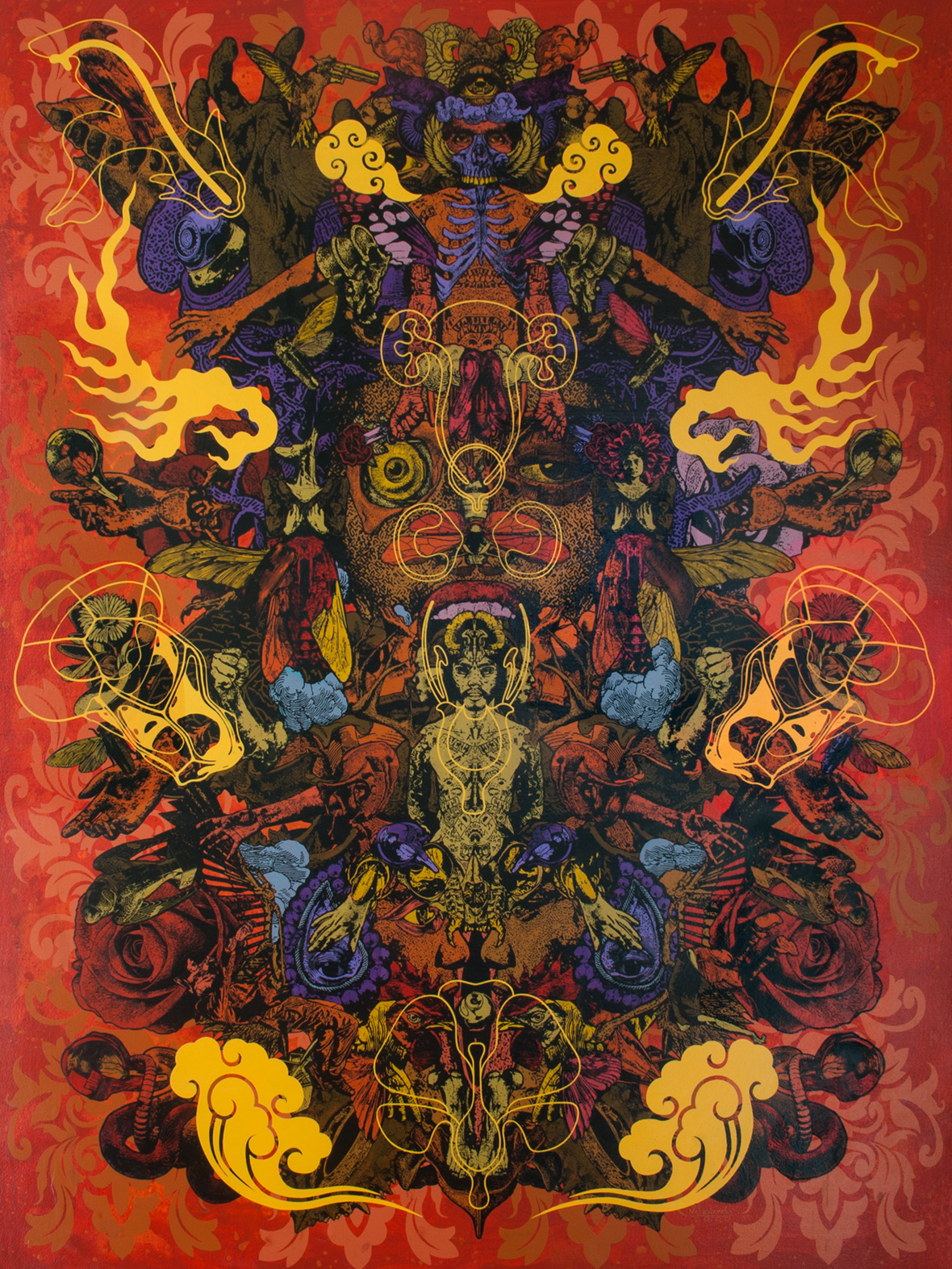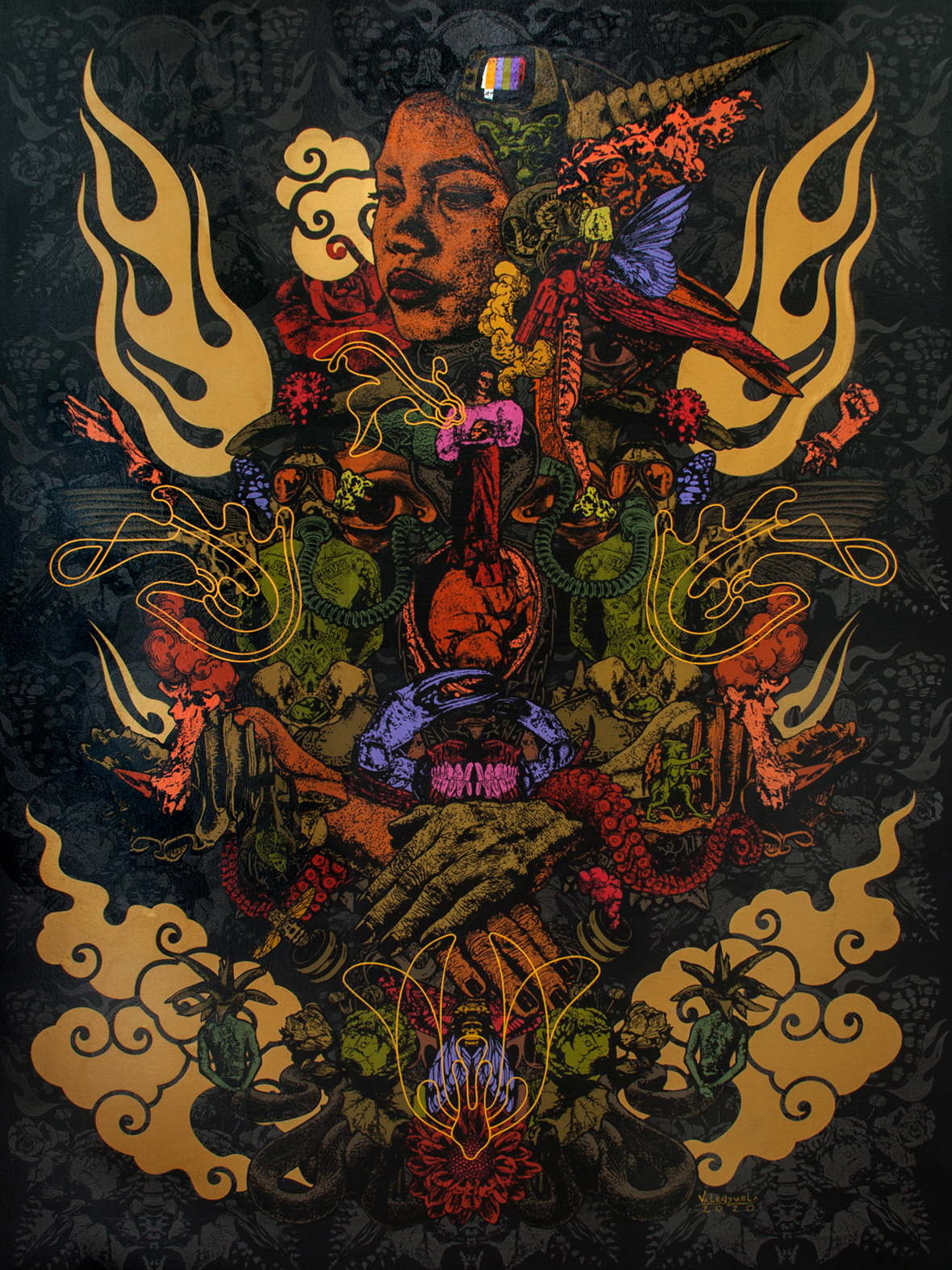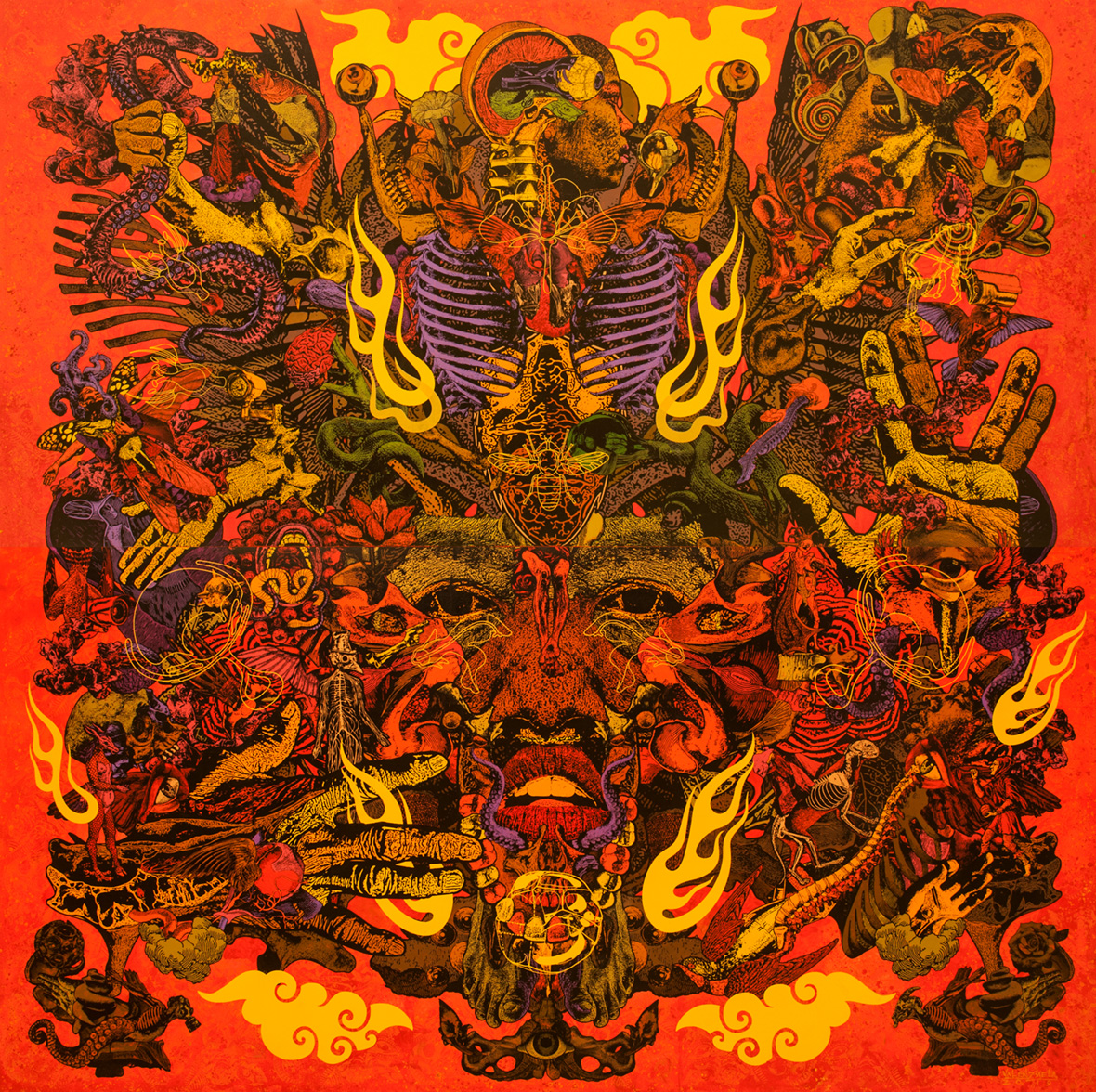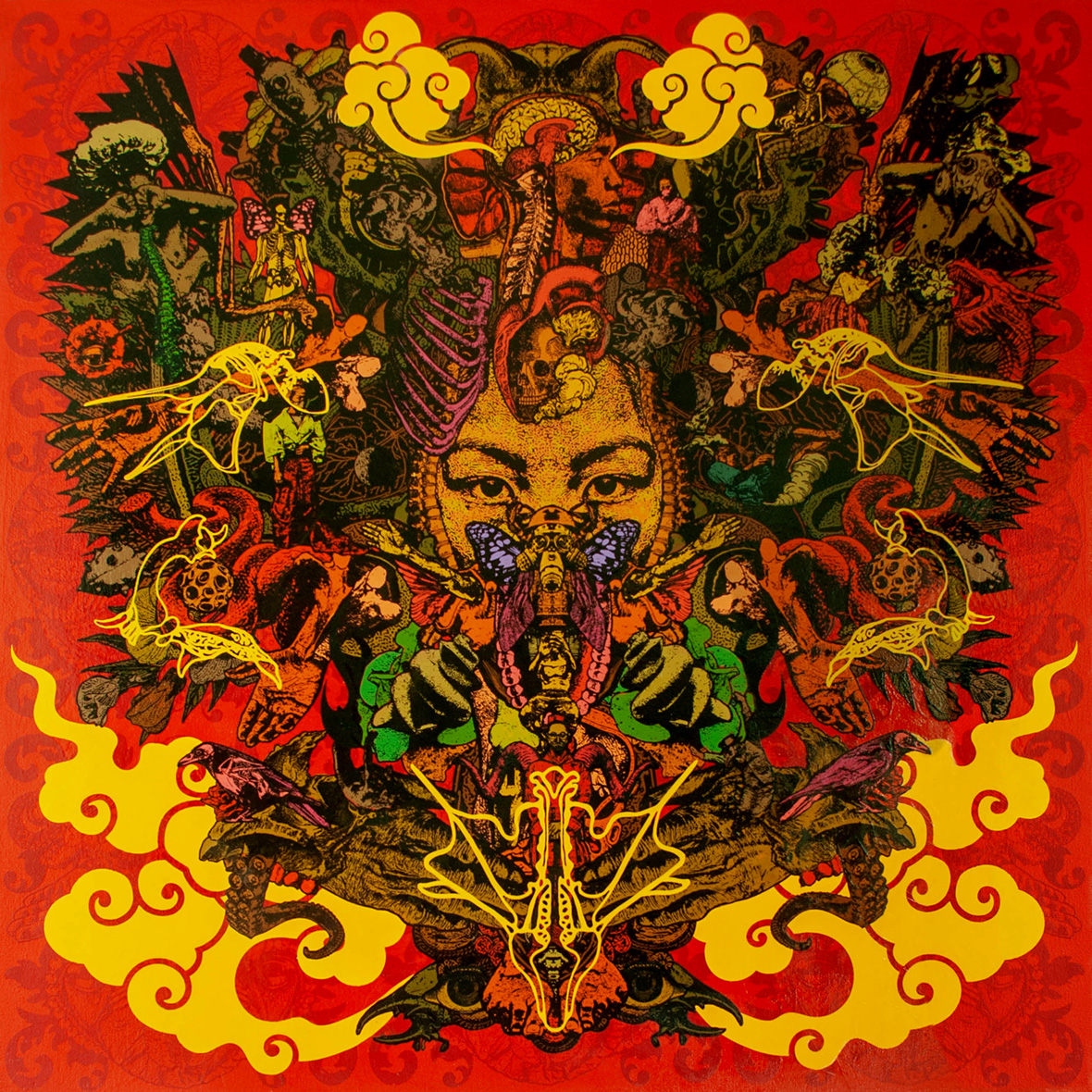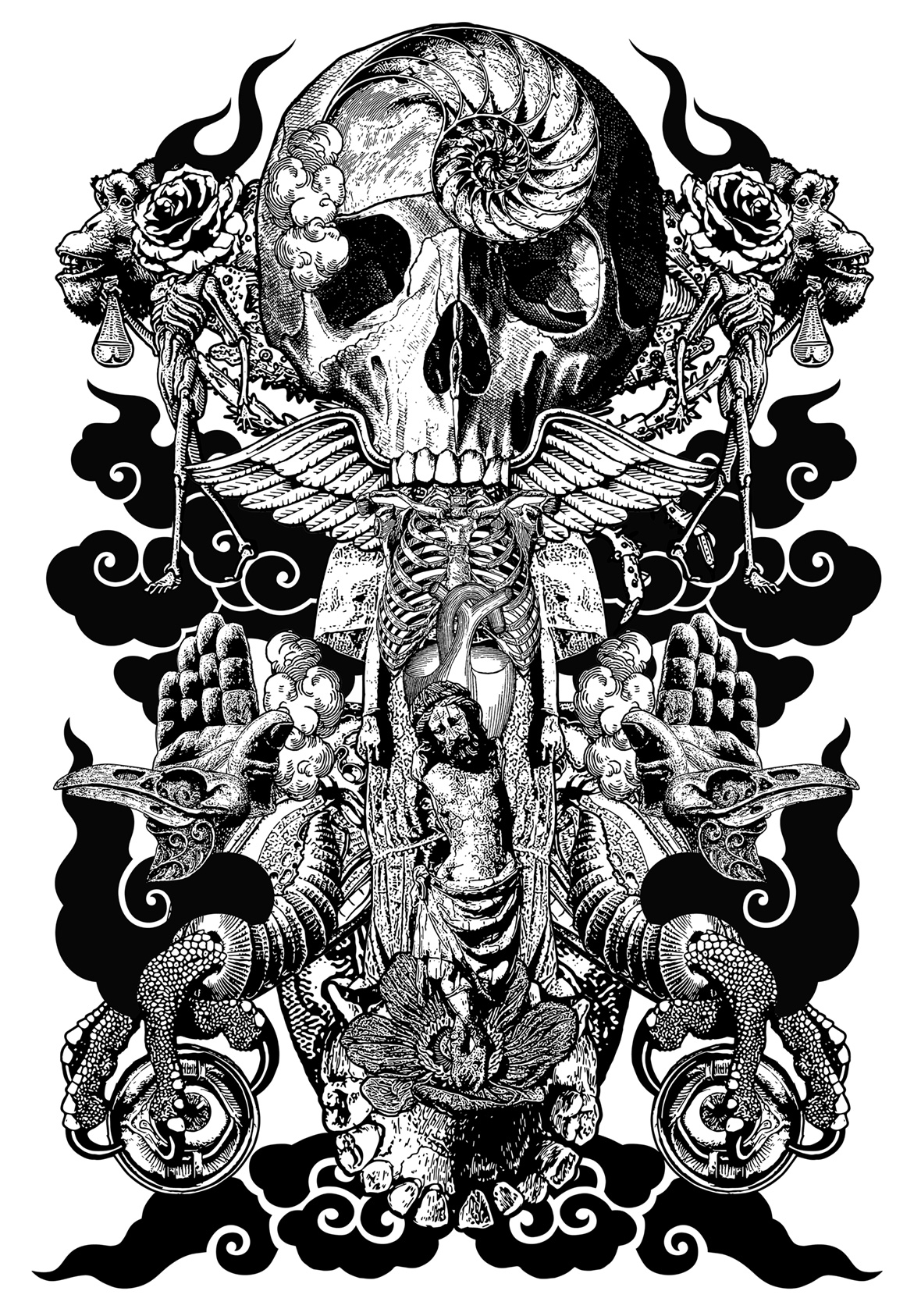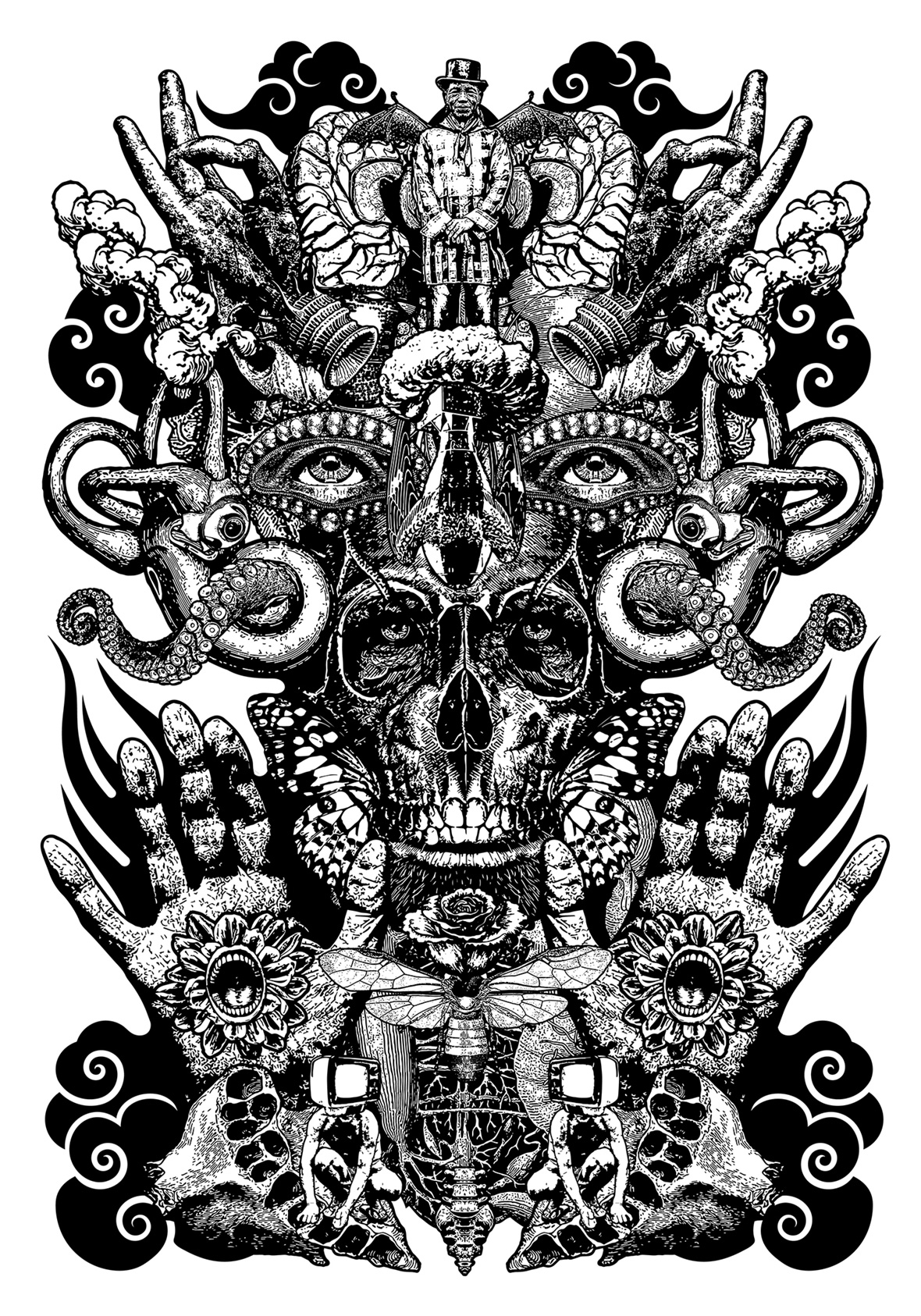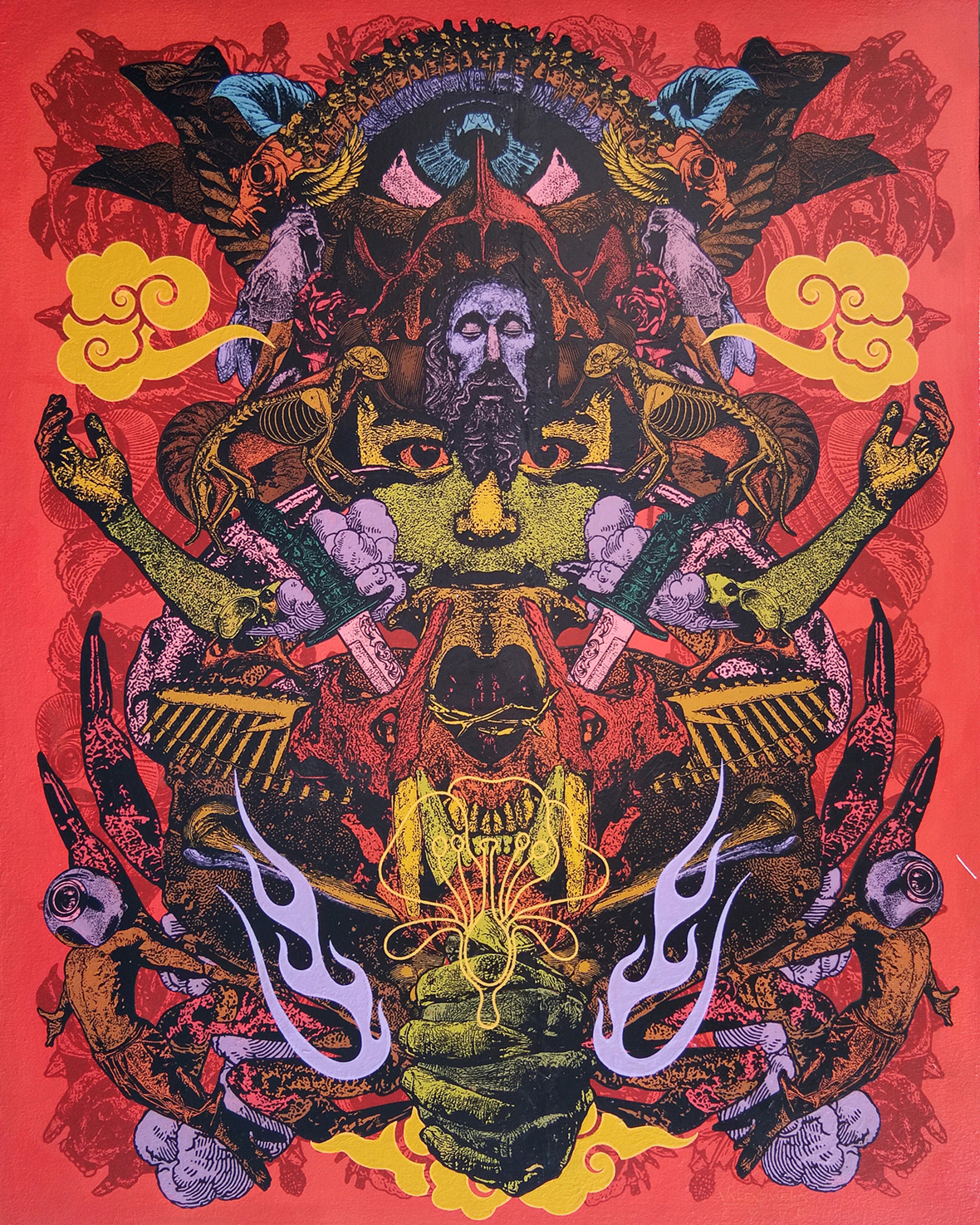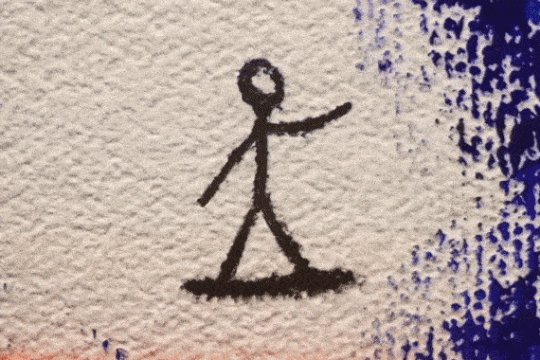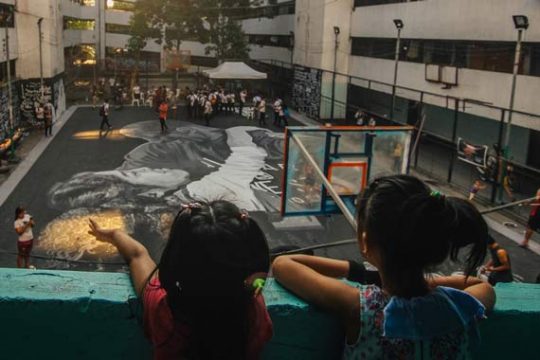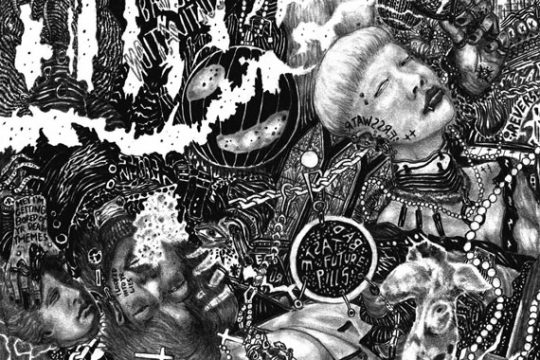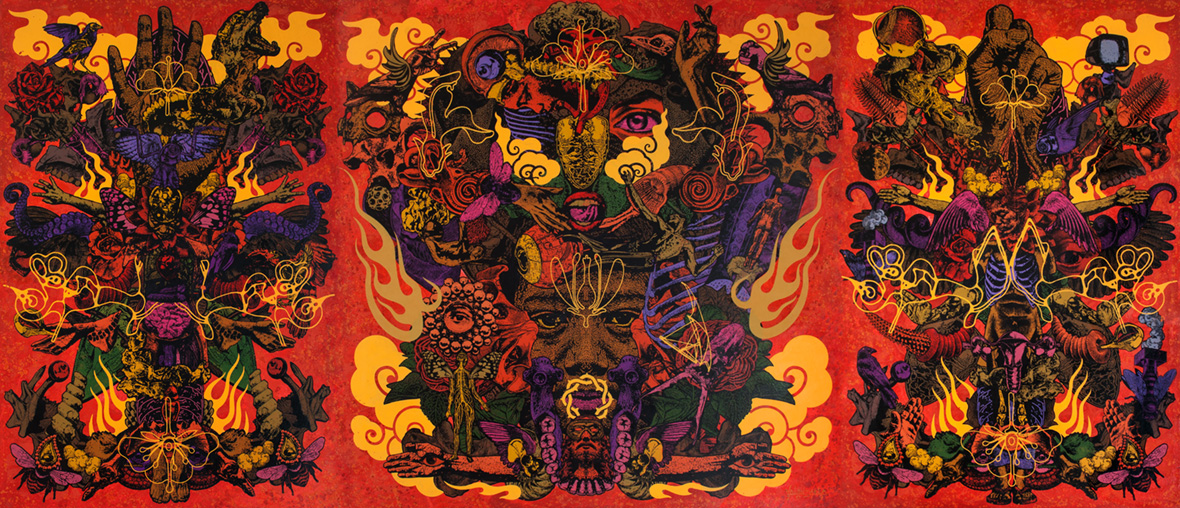
The intricate prints of Wesley Valenzuela are deeply inspired by the city of Manila. He grew up close to Recto Avenue, a busy stretch of road known for its dense cluster of hawkers and diverse mix of visitors. The DIY band merch and comics sold in stalls packed tightly along the curbside; the gaudy art of jeepneys plying oil-stained asphalt; the baroque Christian imagery of the nearby Quiapo, one of the Philippines’ largest and most frequented churches. He absorbed all of this over the years and it manifests overtly in his work. “To this day I’m still inspired by Manila,” he says. “The sights, the sounds, all of it. Despite how crazy it is, I really love this place.”
Wesley Valenzuela 精妙绝伦的版画作品与他在马尼拉的生活有着千丝万缕的联系。他打小在雷克托大道(Recto)长大,这是一条繁忙的街道,以鱼龙混杂的小贩和游客闻名当地。地摊儿、杂货当铺、二手店……往往把人行横道搞得水泄不通;花哨的吉普尼中巴车在泥泞的沥青马路上穿行;巴洛克式的奎阿坡教堂(Quiapo)门前总汇集着很多游客,这是菲律宾最大且最受欢迎的教堂之一。多年以来,雷克托大道潜移默化地影响着 Wesley,街道上繁杂忙碌的景象在他的作品中体现地淋漓尽致。“直到今天,马尼拉仍然对我影响颇多。这里的人物、景色、声音,所有的一切,无论有多疯狂,都让我深深热爱着这座城市。” 他说道。如今 47 岁的他对马尼拉这座城市了如指掌。
At 47 years old, Valenzuela has seen a lot of Manila, and he credits his elementary school for sparking an interest in art. The school actively sought out talented students, encouraging them to take part in dancing and art events. They enrolled those interested in afterschool programs and helped enter them in competitions all over the city. “I was pretty educated about painting by the time I got to college,” he says. To take his knowledge in new directions, he enrolled in graphic-design courses during university. He later went on to teach art at a couple universities in the late ‘90s to the mid-2000s. Combining all these experiences, he looked to his city and popular culture to drive his personal work.
Wesley 对艺术的兴趣最早来自小学。当时学校为了激发学生的才华与天赋,鼓励他们参加舞蹈、歌唱等各类艺术活动。学校招募对此类课后项目感兴趣的学生,带他们到全市各地参加比赛。当时,Wesley 毫不犹豫地选择了绘画。直到大学的时候,他便早已受了很多绘画方面的训练,展现出颇具成熟的绘画功底。不过为了开拓新的领域,他在大学修读了平面设计专业。之后在 90 年代末到 00 年代中期,他陆续任教于当地几所大学。丰富经验的基础上,他开始把目光转向自己生活的城市及当地文化,以此来挖掘个人作品的更多可能性。
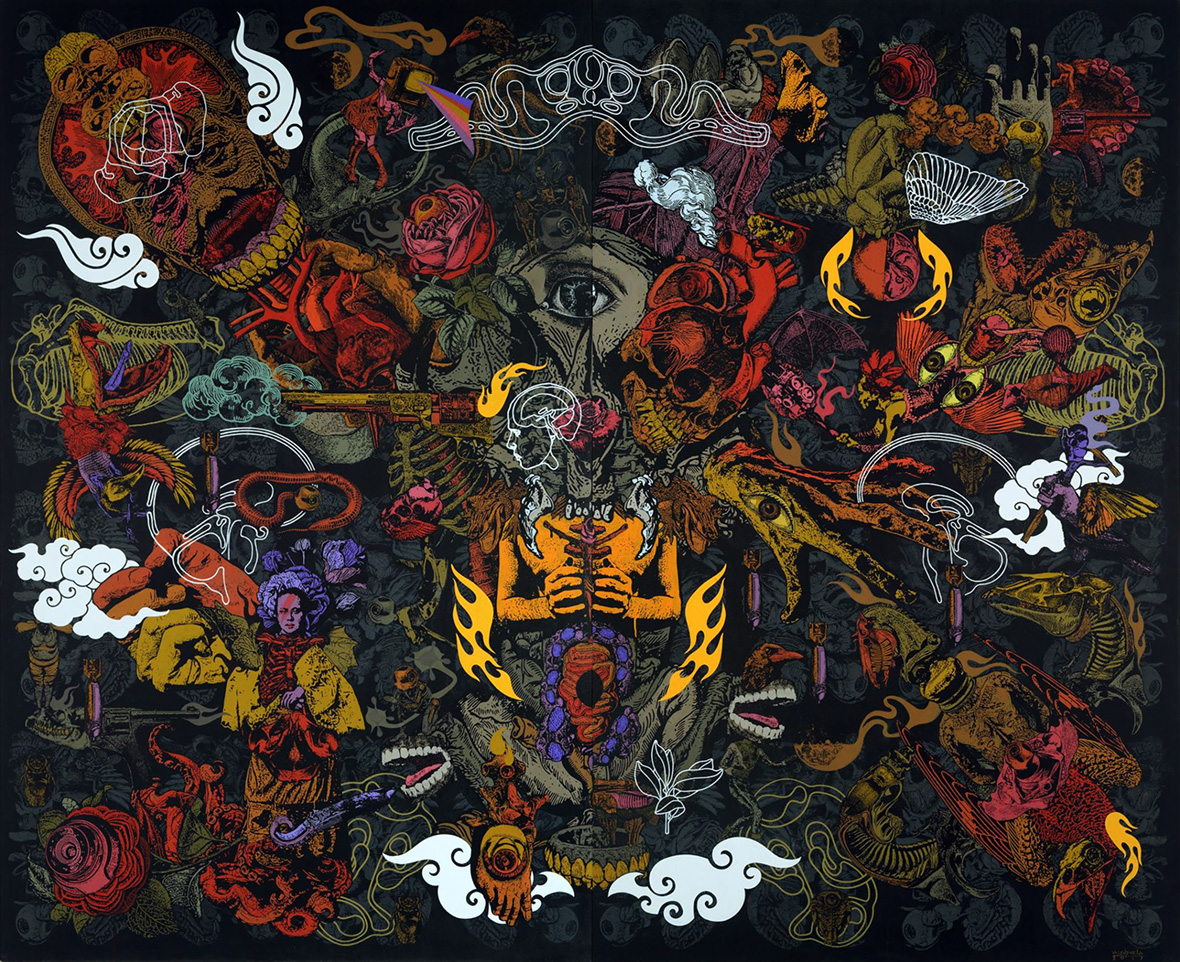
“I went through a few phases,” Valenzuela says. Under the spell of jeepney art, he picked up airbrushing for a while. And later on, he collected found objects to make sculptures. He experimented with print-transfer art for a time as well. You can still find some of these pieces in his studio, which is next door to his family’s home, where they’ve lived since before World War II when much of the city was destroyed. It was in the mid-2000s when he began toying with a rudimentary version of his current style, inspired by the earlier works of Banksy and Shepard Fairey. “There were students at my school who were a part of the nascent graffiti scene here, and since I was still kind of young, I went to a few spots with them where I first tried the style out.”
Wesley 说:“我的创作经历过几个不同阶段。”他曾就因为对吉普尼艺术感兴趣,甚至一段时间沉迷于喷绘;也有过热衷于收集旧物的经历,用它们来制作大型雕塑;有一段时间他还尝试了转印艺术(print-transfer art)。现在,那些昔日的作品就摆放在他的工作室里。 Wesley 的工作室就在他住处的旁边,他和家人自二战前就一直住在那里,当时,城市大部分地方已几近被战争摧毁。直到 2000 年代中期,他才逐渐形成现在的艺术风格,其灵感来自街头涂鸦艺术家 Banksy 和街头艺术家 Shepard Fairey 的早期作品。“当时正值涂鸦艺术在菲律宾盛行,那时我还比较年轻,和大学朋友第一次尝试了涂鸦。”
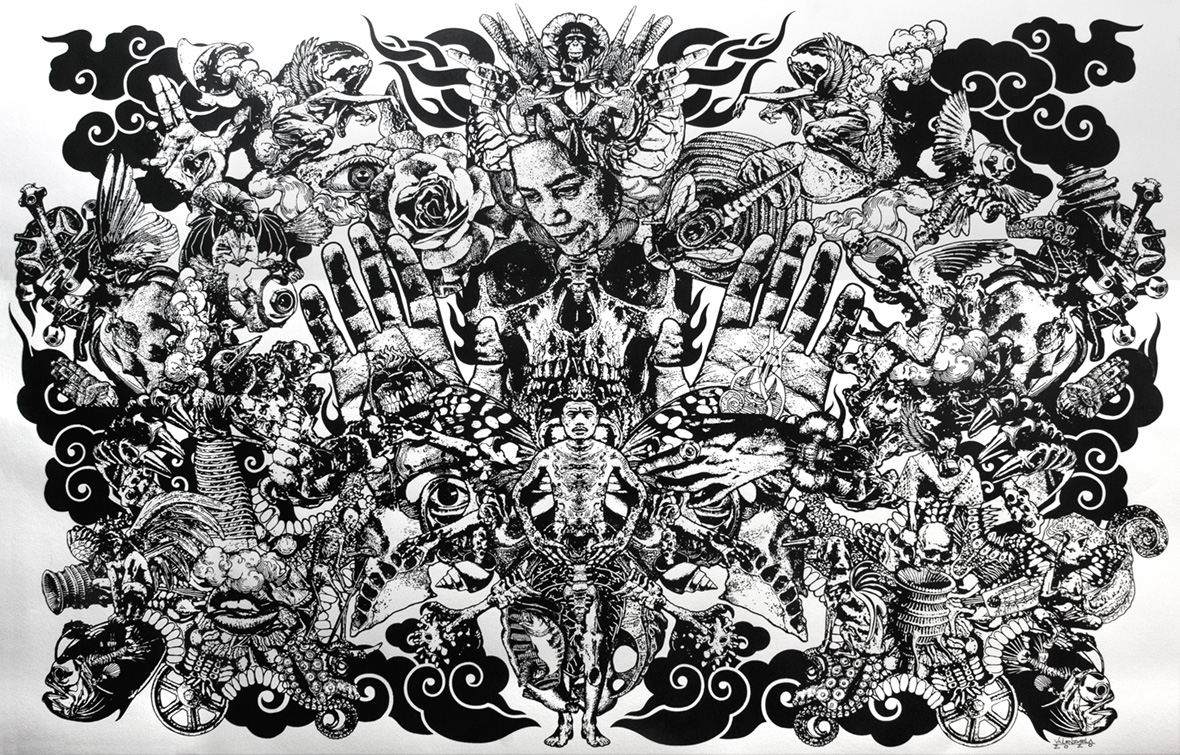
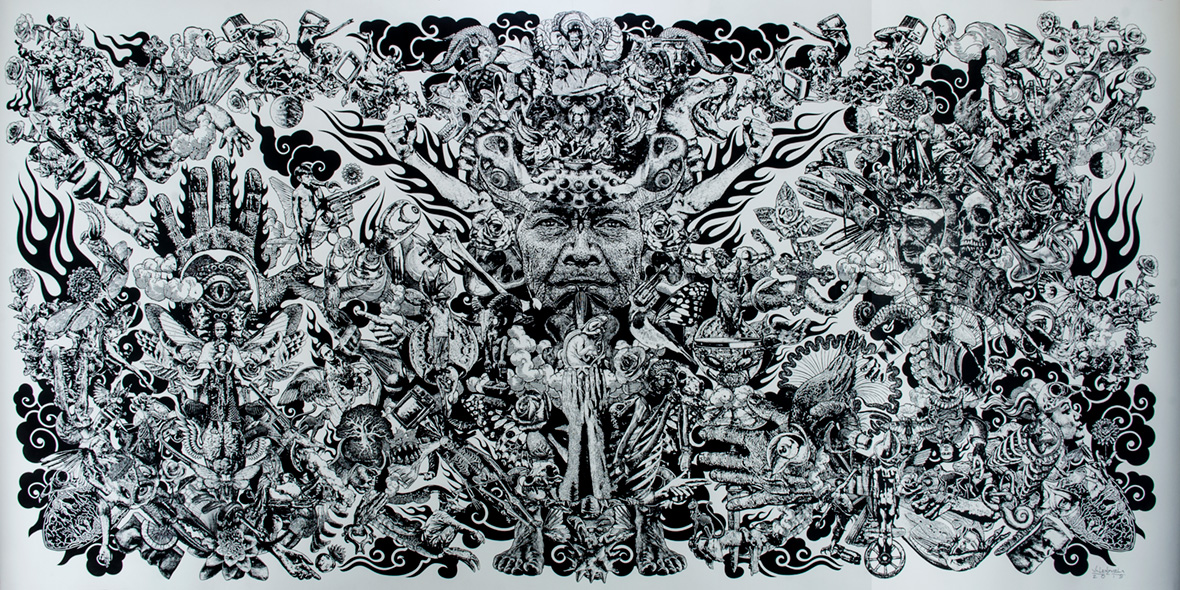
He took those stencil experiments and applied them to silkscreen printing, a medium he was familiar with thanks to an infatuation with local rock bands. “In the late ’80s and early ’90s, hardcore and punk bands were creating their own album artwork and shirts, which really inspired me,” he recalls. “I still play in bands, but it’s more chill stuff like shoegaze because I’m older now.” Although the style started with basic imagery, it evolved into the more maximalist style he’s now known for. “Filipino aesthetics are very baroque, just look at the jeeps and the churches.” He now uses about ten screens per canvas, changing them up each time. “I work in themed series but I never reproduce a piece exactly.” The objects that appear in his images are collected online and from his own photos, which he alters in Photoshop before assembling them in his massive collages. He starts each print with a black silk-screened outline, which he fills in with acrylic paints and adds additional layers of silkscreen on top. “It’s kind of like a coloring book.”
特别的是, Wesley 随后将涂鸦运用到丝网印刷的工艺上,这在当地很少有人尝试。而谈到他和丝网印刷的结缘,则要从他与摇滚乐之间的故事开始说起。他回忆道:“80年代末90年代初,当时的很多硬核和朋克乐队常常 DIY 专辑封面和文化体恤,他们通常以丝网印刷的形式来制作,让图案看上去更有质感。这对我启发很大。事实上,摇滚乐对我的影响很多,我现在也有自己的乐队,偶尔会去表演。”
Wesley 最初的个人创作从简单的意象开始,之后逐渐演变成现在的极繁主义风格。“菲律宾人喜欢巴洛克,你看那些吉普尼车和教堂就知道了。”现在, 他 每张画布大约会用十个丝网,每次创作都需要更换。“我的每一幅作品都有不同的表达和主题,所以从来不会照搬或复制任何一幅作品的模板。”作品中出现的一些具象事物来自于网络、另一些则来自他拍摄的照片。通常,他会先在 Photoshop 上对图像进行编辑,然后再放在丝网上进行加工和拼贴。每次创作版画时,他会先选择一个黑色的丝网轮廓,用丙烯颜料填充,然后再在上面添加其他的丝网层。“感觉有点像在上色,”他笑着说道。
If you study the spiraling motifs of his work, certain themes emerge. There are firearms, which represent violence in the city, especially since the drug war started. There are lots of cameras, bringing to mind the near-ubiquitous surveillance of our era. And there is plentiful religious iconography, including Buddhist-inspired imagery. He also includes Filipino animism, which overlaps with his other topics. The all-seeing eye of God is common, which blends Christianity with Filipino folklore and omniscient surveillance. Moths and dragonflies transmit the belief that departed loved ones revisit the living in the form of insects. Bones and skeletons further the topic of death while also blending with the pop-culture references scattered throughout. “Filipinos assimilate a lot of stuff, through colonization and imperialism. It changes us a lot, but we retain a lot of tradition as well, and we become something new,” he notes. “I want my audience to study my work and think about all the small details. They don’t need to know my actual intent but think for themselves and discover their own personal meaning. It’s almost like looking at an ink blot.”
如果你仔细观察作品中层叠的图案,不难发现其中暗藏的主题元素。譬如枪械,代表这座城市的暴力,尤其自从毒品战争开始以来诱发的暴力事件;摄像头,折射这个时代几乎无处不在的监视;还有大量的宗教元素,包括佛教图像。他还加入了菲律宾的泛灵论(Animism,起源于十七世纪,认为天下万物皆有灵魂或自然精神,并在控制间影响其他自然现象)。这些元素交织在一起,带带来十足的视觉震撼效果。
同时,作品也会传达种种“上帝视角”的隐喻,例如基督教、菲律宾民间传说和摄像头元素,表达被监视的生活。飞蛾和蜻蜓则传递某种信念,许多民间传统认为逝去的亲人会化成昆虫,探访在世的人;死亡的主题的骷髅头的意向中被进一步探讨,裹挟了各种菲律宾流行元素。他说:“在经历了殖民和帝国主义,菲律宾被同化了很多,也很大程度上改变了我们。但同时,传统也依然被保留了下来,与西方文化融合出全新的内容。我希望观众能仔细研究我的作品,琢磨其中的一些小细节。他们不需要猜出我的真实意图,只需要用心去思考,从中发现他们自己内心的解读,就像在进行墨迹心理测试那样。”(Rorschach Test,墨迹心理测试是二十世纪初瑞士医生斯齐曼用水墨卡来分析人内心状态的一种方式,测试由十张墨水卡组成,通过测试者对卡片内容的理解,来界定他们当前的心理状态)
Like our stories? Follow us on Facebook and Instagram.
Instagram: @wesndestroy
Contributor: Mike Steyels
Chinese Translation: Olivia Li

